Research
I am interested in working at the interface of theoretical modelling and observations, seeking to refine our understanding through an apples-to-apples comparison by forward modeling simulations.
Below you will find some of the research that I have been involved with. If you are interested, feel free to get in touch
First Light And Reionisation Simulations (Flares)
The Flare simulations (Flares) are a suite of high-resolution hydrodynamic simulations of galaxy formation and evolution using the Eagle physics. The suite consists 40 zoom resimulations of spherical regions selected at z=5 from a 3.2 cGpc a side, parent dark matter-only box. We select a range of overdensities in order to study the environmental effect on high-redshift galaxy evolution. We also combine these resimulations in order to produce composite distribution functions, signficantly extending the dynamic range of the model over smaller volume, periodic simulations. The introductory papers can be found at Lovell et al. (2021) and Vijayan et al. (2021).
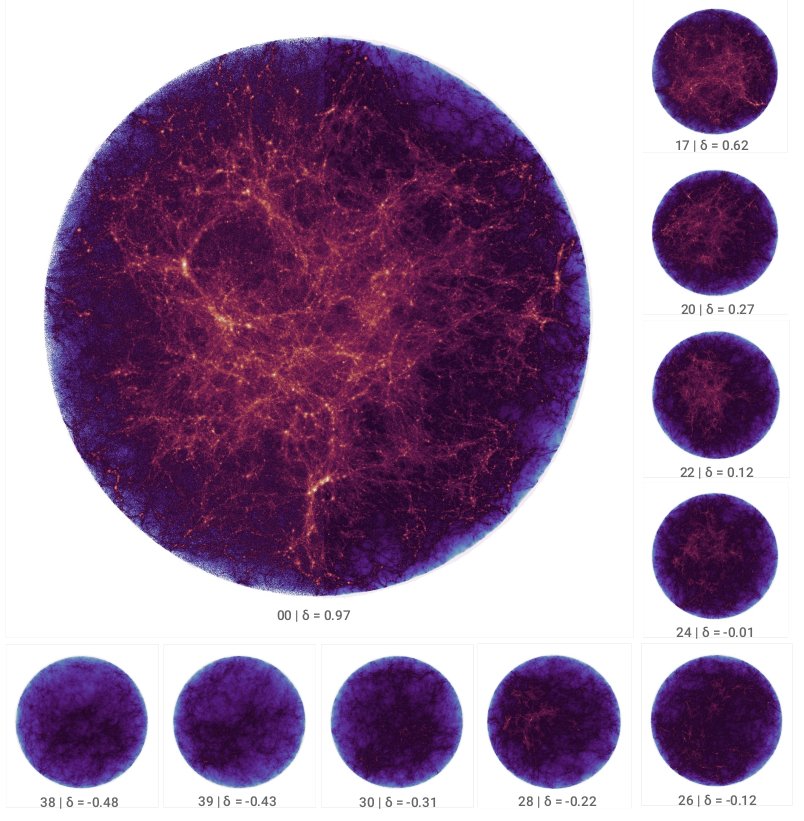
DM visualisation of a few selected regions in Flares.

Combined cumulative galaxy number counts of Flares compared to the Eagle Reference simulation volume. Flares has more than ~20 times galaxies with stellar mass greater than 1010 M⊙.
The increased dynamic range probed by Flares allows us to make predictions for a number of large area surveys that will probe the EoR in coming years, such as Euclid and Nancy Grace Roman Space Telescope as well as JWST. As can be seen from the cumulative galaxy mass function plot above, the mass range has been significantly extended compared to the Eagle reference volume. Also Flares has access to a much larger sample of galaxies, thus providing a useful statistical sample of galaxies accessible to upcoming facilities.
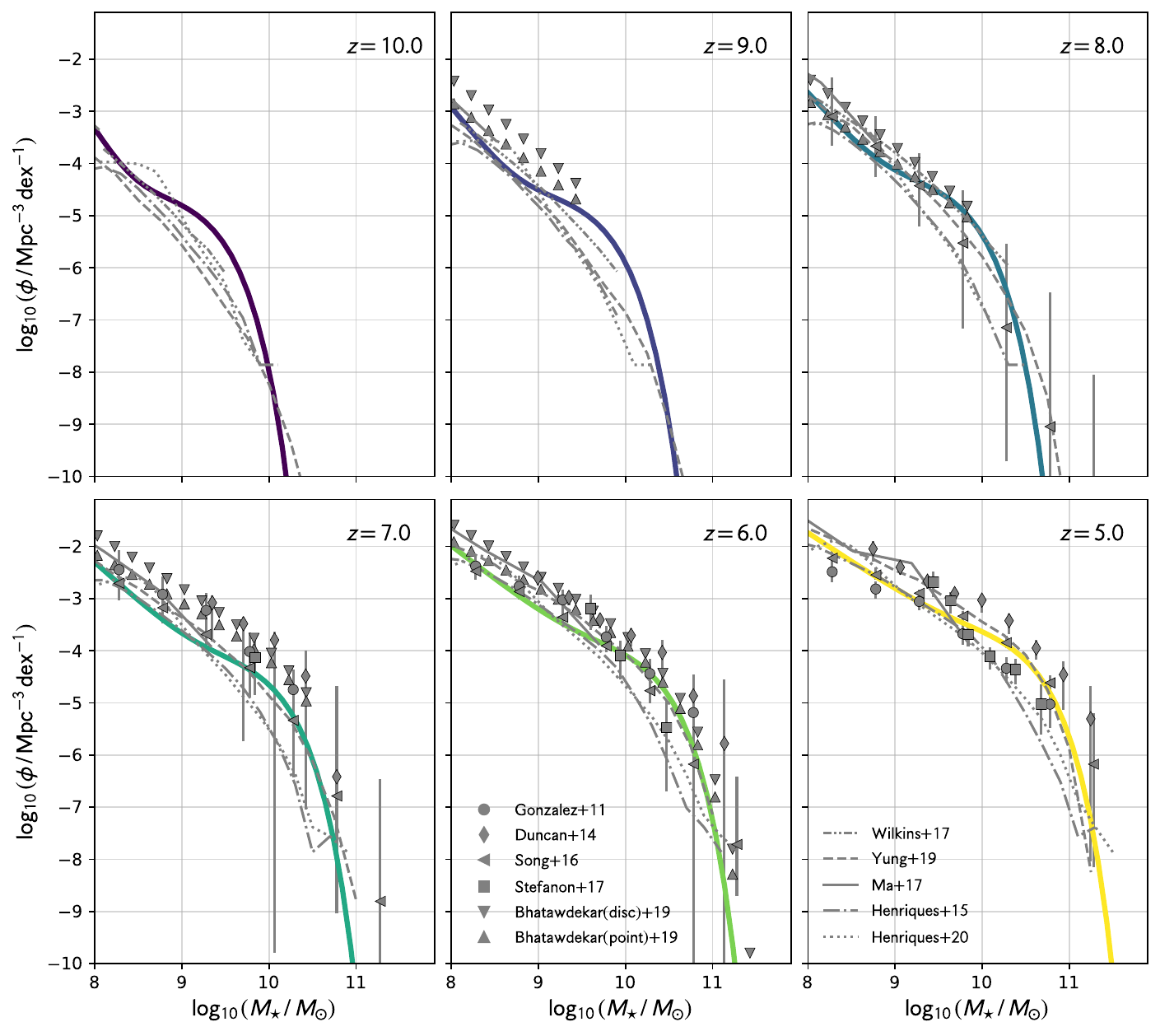
Stellar mass function of the Flares galaxies in z=5-10, observations and model values are plotted alongside.
Flares Line-of-sight dust modelling
We use a line-of-sight (LOS) dust extinction model to model the photometric properties of the galaxies in the simulation. This is done by assuming that the dust optical depth along the line of sight is proportional to the LOS dust column density. We convert the LOS metal density for each star particle to a dust density based on the dust-to-metal ratio fitting function presented in Vijayan et al. (2019). We calibrate the proportionality constant based on the luminosity function at z=5 presented in Bouwens et al. 2015 as well as the UV-continuum slope from Bouwens et. al (2014) at z=5 and the [OIII] doublet EW measurements at z=8 from deBarros et al. (2019).
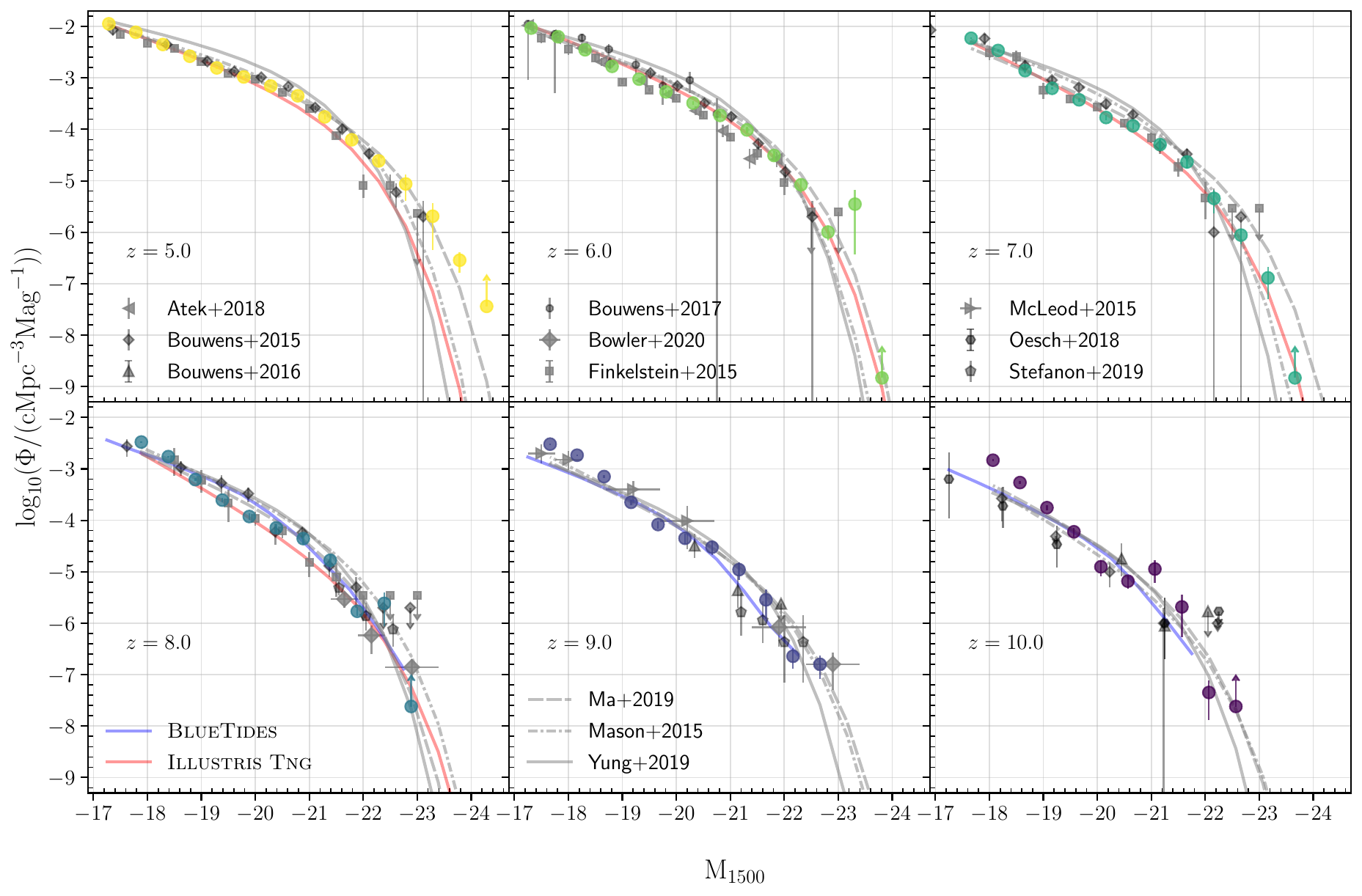
UV luminosity function of the Flares galaxies in the range z=5-10. Also shown are data points from observations and models. The Flares galaxies extends the UV luminosity function to the very brighter regime.
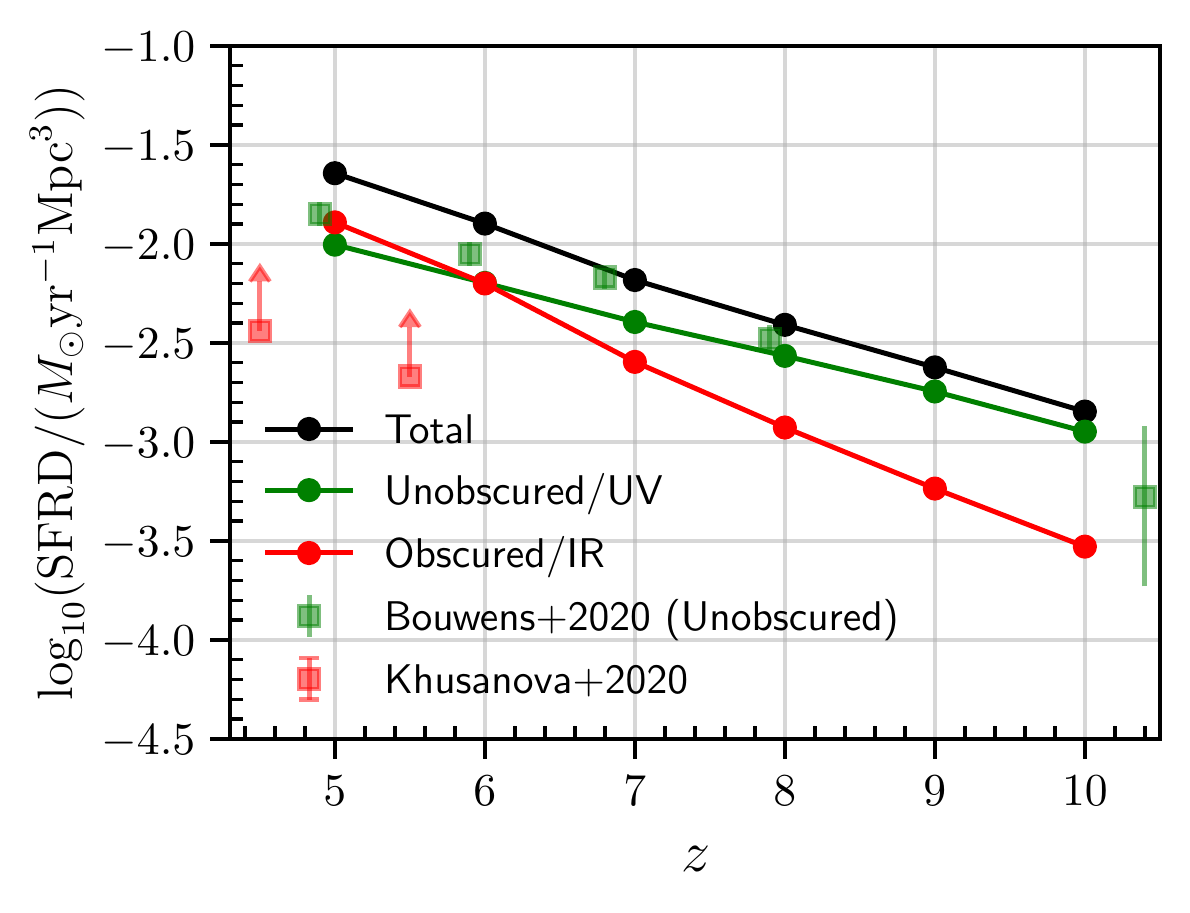 The star formation rate density evolution as probed by Flares.
The star formation rate density evolution as probed by Flares.
Flares-skirt modelling
We modelled the full SED of the galaxy in post-processing using the radiative transfer code [skirt](https://skirt.ugent.be/) in Vijayan et al. (2022). The modelling assumptions builds upon previous Eagle-skirt work done in Camps et al. (2016) and Trayford et al. (2017). We look at the infrared luminosity function, the infrared excess (IRX) and the light-weighted dust temperatures of the most massive galaxies in Flares in the redshift range 5-10. We find that the IR LF is underpredicted at bright IR luminosities compared to current observational results. We see that the Flares IRX-β relation mainly follows the local starburst relation. We also see an evolution of the light-weighted dust temperatures towards higher values with increasing redshift.
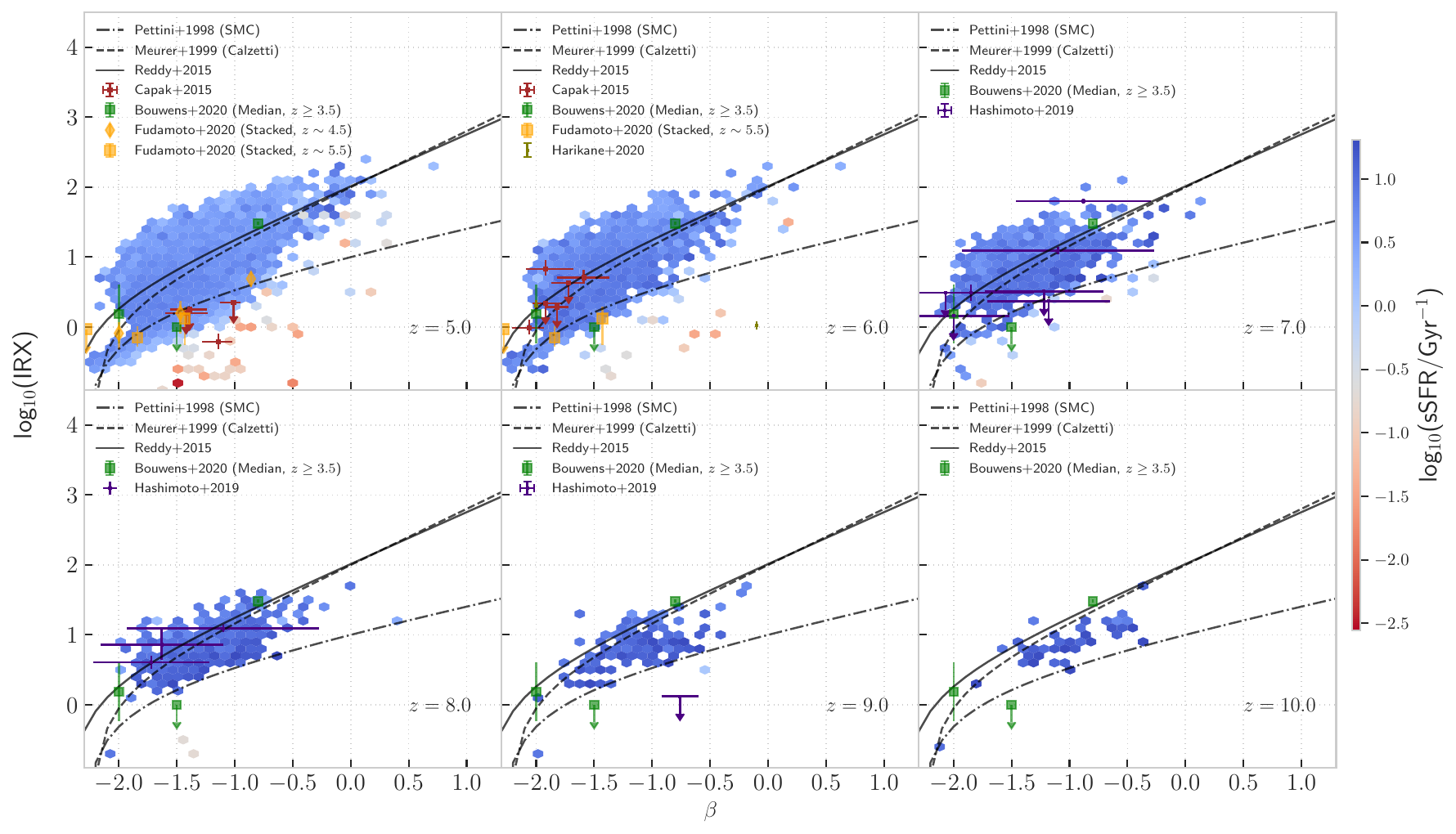 The IRX-β relation of Flares galaxies at z=5-10 coloured by their specific star formation rate. Also shown is some observational and theoretical data at these redshifts.
The IRX-β relation of Flares galaxies at z=5-10 coloured by their specific star formation rate. Also shown is some observational and theoretical data at these redshifts.
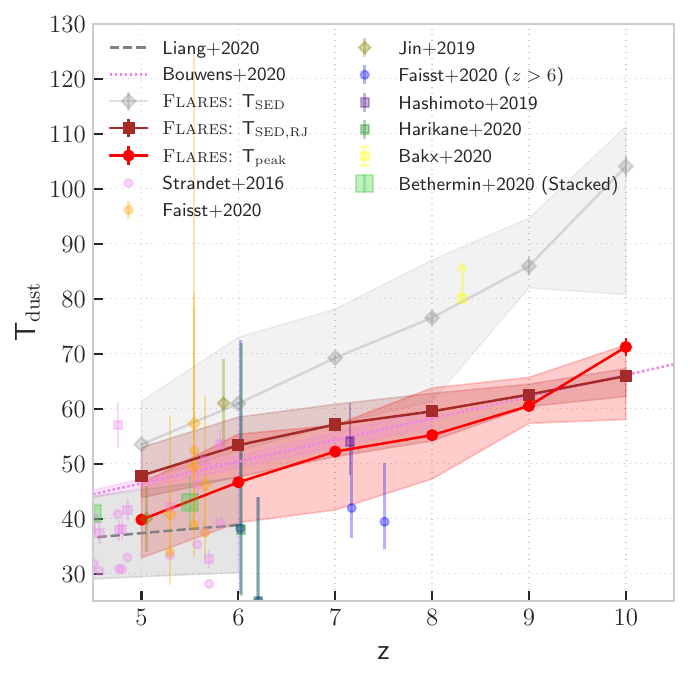 The redshift evolution of the light-weighted dust temperatures of the Flares galaxies at z=5-10. Tpeak is the wavelength at which the IR flux density peaks, TSED is the dust temperature obtained from fitting a mid-IR powerlaw + modified MBB to the IR SED while TSED,RJ is the temperature from an optically-thin MBB. Also shown is some observational and theoretical data at these redshifts.
The redshift evolution of the light-weighted dust temperatures of the Flares galaxies at z=5-10. Tpeak is the wavelength at which the IR flux density peaks, TSED is the dust temperature obtained from fitting a mid-IR powerlaw + modified MBB to the IR SED while TSED,RJ is the temperature from an optically-thin MBB. Also shown is some observational and theoretical data at these redshifts.
Dust Modelling in L-Galaxies Semi-Analytical Model
L-Galaxies is a semi-analytical model (SAM), implemented on the Millennium (Springel et al. 2005) and Millennium-II (Boylan-Kolchin et al. 2009) simulation merger trees. The model has been developed over the years to include the relevant processes required for galaxy evolution. The model has been really successful in matching many of the observational results like the galaxy stellar mass function across redshifts (Henriques et al., 2015), (2020), the high redshift ( z ≥ 4 ) UV luminosity function (Clay et al., 2015). A self-consistent model of dust formation and evolution has been incorporated in the L-Galaxies' SAM, which is built on top of the (Henriques et al. 2015) model.
 The dust-to-metal ratio as a function of their metallicity from z = 0-8. The orange line shows the median result from galaxies in our model, with the dashed lines denoting the 84 and 16 percentiles. Green blue and red points show the observational constraints from Rémy-Ruyer et al. (2015), De Cia et al. (2016) and Wiseman et al. (2017) respectively.
The dust-to-metal ratio as a function of their metallicity from z = 0-8. The orange line shows the median result from galaxies in our model, with the dashed lines denoting the 84 and 16 percentiles. Green blue and red points show the observational constraints from Rémy-Ruyer et al. (2015), De Cia et al. (2016) and Wiseman et al. (2017) respectively.
 The dust-to-metal ratio as a function of stellar mass from z = 0 − 8, with galaxies coloured according to their mass-weighted stellar age in Gyrs. Green points show the observational constraints from Rémy-Ruyer et al. (2015).
The dust-to-metal ratio as a function of stellar mass from z = 0 − 8, with galaxies coloured according to their mass-weighted stellar age in Gyrs. Green points show the observational constraints from Rémy-Ruyer et al. (2015).